As part of my DLL coursework in EDLD 5305, I created an innovation plan which involves establishing an online course in Technology-Assisted Music. The details of that plan can be found here, but, in summary, the intent is that this course will help both students and teachers use the study of digital audio production to enhance their creative skills, both individual and collaborative, and to develop a growth mindset, which is vital to any sort of learning.
While some of the work in the Technology-Assisted Music course involves mastering digital production tools and techniques, these are all in service of the overall goal of making music, and of enabling the learners to create work that is meaningful to them; this is the true goal of the course. In pursuit of this goal, learners will both benefit from and, in the case of teachers, learn to create significant learning environments.
The many benefits of creating significant learning environments (CSLE) and the authentic learning experiences they inspire are outlined by Harapnuik (n.d.). When learning becomes student-centered, and designed by working backward from a desired end result (for example, the creation of a portfolio of musical work that is personally meaningful to the learner), student engagement is increased, and the learning activities become more authentic–concepts and skills acquired are directly relevant to the task at hand. Students in such an environment are able to take advantage of the wide array of resources and information available to them, not just from the teacher, but from their peers and from wider social networks. Teachers are able to move beyond being strictly deliverers of content and assume the roles of coach and mentor, developing a deeper and more trusting relationship with learners.
The Technology-Assisted Music course makes full use of the advantages of significant learning environments, and furthermore is intended to help teachers develop such environments for their own students. The ultimate goal of the course is to help learners develop a growth mindset and explore the creative process through the creation of musical works that are meaningful to them. This is student-centered learning at its most essential: the student determines what sort of creative work is meaningful to them, and then, through investigation, experimentation and reflection, discovers the best tools and techniques to create that work. As part of this process, the instructor, while serving as an informational resource about those tools and techniques, can also serve as a personal coach to the learner, providing feedback on both the process and the product, and utilizing the one-on-one relationship with the learner to help develop a growth mindset, treating evaluation and feedback not as a judgement on artistic merit, but as a learning tool. This type of trust can be challenging to develop, since few things are more personal and elicit such vulnerability as sharing one’s individual creative work with an audience and asking for critique; however, the effort to develop such such trust is well worth it. Hattie (2009) lists formative evaluation and feedback given within such a relationship as being among one of the strongest influences on student achievement.
This interpersonal feedback relationship will also be developed among learners in the course, as they share their work with one another and provide feedback and commentary, and also share information about what their learning inquiries have uncovered–as students explore a variety of different projects, they will of course encounter a variety of ways to achieve the goals of those projects. Furthermore, learners will be able to social networking elements of the audio production software used in the course to collaborate with other creators both within and outside of the course, sharing projects and exploring online communities and knowledge bases. This element of the significant learning environment takes advantage of many of the same elements that Thomas and Brown (2011) highlight in their description of massive multiplayer online game environments: participants “absorb tacit knowledge, process it into a series of increasingly sophisticated questions, and engage collectives to make the experience more personally meaningful” (p. 107).
As teachers enrolled in the professional development version of the course experience a significant learning environment from a learner’s perspective, they will gain valuable insight on creating such environments in their own classrooms; indeed, reflection on this very topic will be part of the teacher course. The goal for these teachers is that they will want their own students to have the same kind of significant, authentic learning experience that they themselves had, and will work to create it. In this way, the Technology-Assisted Music course will not only benefit the learners themselves, but will impact students and teachers across the district. Students who develop growth mindset skills in the process of creating, evaluating, and revising musical work will be able to apply those skills in other academic areas. Teachers will know firsthand what kind of deeper learning occurs when that learning is student-centered and inquiry-driven. It is my hope that creating significant learning environments for these learners will encourage a slow but far-reaching and fundamental shift in the way our students experience learning, in all disciplines.
REFERENCES
Harapnuik, D. (n.d.). CSLE [Blog post]. Retrieved from http://www.harapnuik.org/?page_id=849
Hattie, J. (2016). Hattie ranking: Backup of 138 effects related to student achievement [Blog post]. Retrieved from https://visible-learning.org/2016/04/hattie-ranking-backup-of-138-effects/
Thomas, D., & Brown, J. S. (2011). A new culture of learning: Cultivating the imagination for a world of constant change. Lexington, Ky: CreateSpace?.


